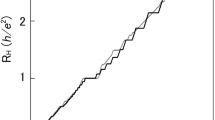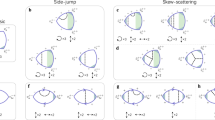Abstract
The integer quantum Hall effect (IQHE) is analysed using a mechanism of the electron transport in the form of semi-classic wave packages in this paper. Due to the confinement of the edges of a slab the Landau levels of electrons in a strong magnetic field go up at large wave-vectors to form energy bands. The slopes of the energy bands give the group velocities of electron wave packages and thus contribute to the current. Certain magnetic fields separate the electron transport in the slab into two branches with opposite and large wave vectors, which are localized at the two edges of the slab, respectively. In this case back scattering of electrons is prohibited due to the localization of these two branches. Thus the slab exhibits zero longitudinal resistance and plateaus of Hall resistance. When the Fermi level is sweeping over a Landau level at some magnetic fields, however, the electron waves locate around the central axis of the slab and overlap each other thus back scattering of electrons takes place frequently. Then longitudinal resistance appears and the Hall resistance goes up from one plateau to a new one. This transport mechanism is much clearer and more intuitive than the conventional explanations to the IQHE.
Similar content being viewed by others
References
K. von Klitzing et al., Phys. Rev. Lett. 45, 494 (1980)
D.C. Tsui et al., Phys. Rev. Lett. 48, 1559 (1982)
C.-Z. Chang et al., Science 340, 167 (2013)
R.E. Prange, Phys. Rev. B 23, 5632 (1981)
R.E. Prange, The Quantum Hall Effect, 2nd edn. (Springer-Verlag, 1990)
Z.F. Ezawa, in Quantum Hall Effects: Field Theoretical Approach and Related Topics, 2nd edn. (Peking University Press, 2012), p. 182
Ni Guangjiong, Chen Suqing, in Advanced Quantum Mechanics (in Chinese) (Fudan University Press, 2000), p. 310
D.J. Thouless, M. Kohmoto, P. Nightingale, M. den Nijs, Phys. Rev. Lett. 49, 405 (1982)
Q. Niu, D.J. Thouless, Y.-S. Wu, Phys. Rev. B 31, 3372 (1985)
Yasuhiro Hatsugai, Phys. Rev. B 48, 11851 (1993)
S. Datta, in Electronic Transport in Mesoscopic systems (Cambridge University Press, 1995), p. 181
Yan Shou Sheng, in Basis on solid state physics (in Chinese) (Peking University, 2003), p. 126
Author information
Authors and Affiliations
Corresponding author
Rights and permissions
About this article
Cite this article
Hui, T., LiMing, W. & Liang, SD. The transport mechanism of the integer quantum Hall effect. Eur. Phys. J. B 89, 257 (2016). https://doi.org/10.1140/epjb/e2016-70496-4
Received:
Revised:
Published:
DOI: https://doi.org/10.1140/epjb/e2016-70496-4




